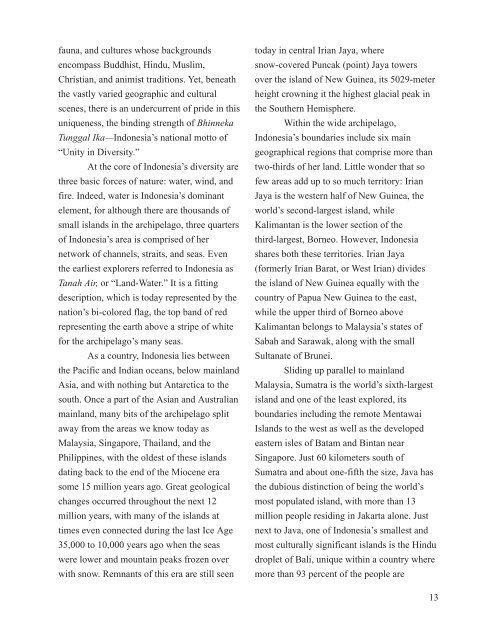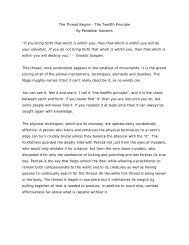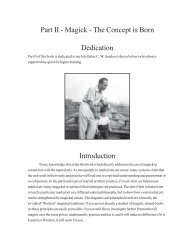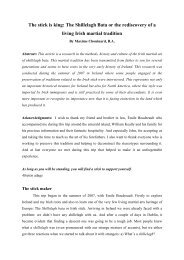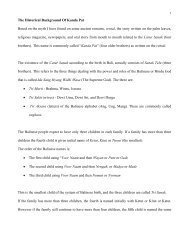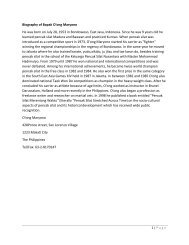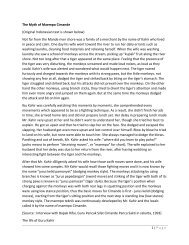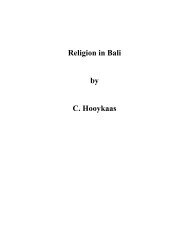Tenaga Dalam - Pukulan Cimande Pusaka
Tenaga Dalam - Pukulan Cimande Pusaka
Tenaga Dalam - Pukulan Cimande Pusaka
You also want an ePaper? Increase the reach of your titles
YUMPU automatically turns print PDFs into web optimized ePapers that Google loves.
fauna, and cultures whose backgrounds<br />
encompass Buddhist, Hindu, Muslim,<br />
Christian, and animist traditions. Yet, beneath<br />
the vastly varied geographic and cultural<br />
scenes, there is an undercurrent of pride in this<br />
uniqueness, the binding strength of Bhinneka<br />
Tunggal Ika—Indonesia’s national motto of<br />
“Unity in Diversity.”<br />
At the core of Indonesia’s diversity are<br />
three basic forces of nature: water, wind, and<br />
fire. Indeed, water is Indonesia’s dominant<br />
element, for although there are thousands of<br />
small islands in the archipelago, three quarters<br />
of Indonesia’s area is comprised of her<br />
network of channels, straits, and seas. Even<br />
the earliest explorers referred to Indonesia as<br />
Tanah Air, or “Land-Water.” It is a fitting<br />
description, which is today represented by the<br />
nation’s bi-colored flag, the top band of red<br />
representing the earth above a stripe of white<br />
for the archipelago’s many seas.<br />
As a country, Indonesia lies between<br />
the Pacific and Indian oceans, below mainland<br />
Asia, and with nothing but Antarctica to the<br />
south. Once a part of the Asian and Australian<br />
mainland, many bits of the archipelago split<br />
away from the areas we know today as<br />
Malaysia, Singapore, Thailand, and the<br />
Philippines, with the oldest of these islands<br />
dating back to the end of the Miocene era<br />
some 15 million years ago. Great geological<br />
changes occurred throughout the next 12<br />
million years, with many of the islands at<br />
times even connected during the last Ice Age<br />
35,000 to 10,000 years ago when the seas<br />
were lower and mountain peaks frozen over<br />
with snow. Remnants of this era are still seen<br />
today in central Irian Jaya, where<br />
snow-covered Puncak (point) Jaya towers<br />
over the island of New Guinea, its 5029-meter<br />
height crowning it the highest glacial peak in<br />
the Southern Hemisphere.<br />
Within the wide archipelago,<br />
Indonesia’s boundaries include six main<br />
geographical regions that comprise more than<br />
two-thirds of her land. Little wonder that so<br />
few areas add up to so much territory: Irian<br />
Jaya is the western half of New Guinea, the<br />
world’s second-largest island, while<br />
Kalimantan is the lower section of the<br />
third-largest, Borneo. However, Indonesia<br />
shares both these territories. Irian Jaya<br />
(formerly Irian Barat, or West Irian) divides<br />
the island of New Guinea equally with the<br />
country of Papua New Guinea to the east,<br />
while the upper third of Borneo above<br />
Kalimantan belongs to Malaysia’s states of<br />
Sabah and Sarawak, along with the small<br />
Sultanate of Brunei.<br />
Sliding up parallel to mainland<br />
Malaysia, Sumatra is the world’s sixth-largest<br />
island and one of the least explored, its<br />
boundaries including the remote Mentawai<br />
Islands to the west as well as the developed<br />
eastern isles of Batam and Bintan near<br />
Singapore. Just 60 kilometers south of<br />
Sumatra and about one-fifth the size, Java has<br />
the dubious distinction of being the world’s<br />
most populated island, with more than 13<br />
million people residing in Jakarta alone. Just<br />
next to Java, one of Indonesia’s smallest and<br />
most culturally significant islands is the Hindu<br />
droplet of Bali, unique within a country where<br />
more than 93 percent of the people are<br />
13


